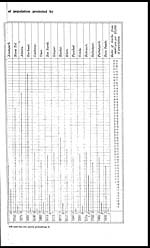Medicine - Vaccination > 1902-1928 - Report on vaccination in the United Provinces > Vaccination United Provinces of Agra and Oudh 1914-1922 > Notes on vaccination in the United Provinces of Agra and Oudh for the year ending 31st March, 1918
(198) Page 6
Download files
Individual page:
Thumbnail gallery: Grid view | List view

( 6 )
85.68 and 59.61, respectively, during the hot weather period (April to September
1917) and of 96.95 and. 73.43, respectively, during the cold weather period (October
1917 to March 1918), against 94.00, 57.28, 97.22 and 68.94, respectively, in 1916-17
as shown below:—
|
Period. |
Primary. |
Re-vaccination. |
||||||
|
Successful |
Unsuccessful. |
Percentage of |
Successful. |
Unsuccessful. |
Percentage of |
|||
|
1917-18. |
1916-17. |
1917-18. |
1916-17. |
|||||
|
April to September |
31,949 |
5,338 |
85.68 |
94.00 |
6,886 |
4,666 |
59.61 |
57.28 |
|
October 1917 to March |
645,255 |
20,287 |
96.95 |
97.22 |
29,485 |
10,666 |
73.43 |
68.94 |
|
Total ... |
677,204 |
25,625 |
96.35 |
97.08 |
36,371 |
15,332 |
70.35 |
67.39 |
The strain of lymph was fortified by passage through rabbits, as usual,
and it proved satisfactory.
The project for installing the electric battery and for erecting the new battery
charging generator at the Dépôt is in hand. The engines in the cold storage plant
worked up to the 30th October 1917 but had to be stopped for want of an expert
and trained mistri and owing to the difficulty of obtaining ammonia for use in the
" compressor ". The pay of the post of the engine driver at the Lymph Dépôt
was raised to Rs. 75—5—100, with the sanction of Government, but no suitable
candidate being available the appointment was not filled.
The experiment of vaccinating calves at Lalkua was continued during the
year under report and was found satisfactory. An epidemic of rinderpest and foot
and mouth disease broke out at Lalkua in December 1917, but timely measures to
check the spread of these diseases were taken.
Contractor Mohammad Noor was again given the contract for the supply of
calves during 1917-18, but he failed to supply the required number in time and so
a fairly large number of calves had to be obtained on fee or purchased locally.
The work and conduct of the Dépôt staff was satisfactory.
Printed rubkars and parwanas.
18. The system of issuing printed rubkars and parwanas in vernacular to
leading official and non-official gentlemen asking
them to render assistance in vaccination work,
introduced in the Kheri District in 1913-14 and detailed in that year's report, was
commended by Government to the notice of all district officers. The lists of
unvaccinated children were, however, ordered to be prepared every third year and
not every year.
Combined birth and vaccination
registers.
19. These registers have now been introduced in almost all the municipali-
ties, notified areas and cantonments in these
Provinces. There exists, however, a diversity of
procedure as regards their preparation and it is
proposed to issue a circular shortly on the subject with the approval of Government.
District annual vaccination
returns.
20. In spite of the issue of a circular on the subject, the district returns and
reports from certain districts were not received on the
date prescribed for their submission.
C. MACTAGGART, C.I.E., M.A., M.B.,
COLONEL, I.M.S.,
Inspector-General of Civil Hospitals and
Offg. Sanitary Commissioner and Superintendent
General of Vaccination, United Provinces.
NAINI TAL :
Dated the 17th June, 1918.
Set display mode to: Large image | Zoom image | Transcription
Images and transcriptions on this page, including medium image downloads, may be used under the Creative Commons Attribution 4.0 International Licence unless otherwise stated. ![]()
| Permanent URL | https://digital.nls.uk/90473328 |
|---|
| Attribution and copyright: |
|
|---|




